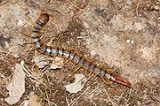
Myriapoda
Overview
Myriapoda is a subphylum
of arthropod
s containing millipede
s, centipede
s, and others. The group contains 13,000 species, all of which are terrestrial
. Although their name suggests they have myriad
(10,000) legs, myriapods range from having over 750 legs (Illacme plenipes
) to having fewer than ten legs.
The fossil record of myriapods reaches back into the late Silurian
, although molecular evidence suggests a diversification in the Cambrian Period, and Cambrian fossils exist which resemble myriapods.
The scientific study of myriapods is myriapodology, and those who study myriapods are myriapodologists.
Myriapods have a single pair of antennae
and, in most cases, simple eyes.
Subphylum
In life, a subphylum is a taxonomic rank intermediate between phylum and superclass. The rank of subdivision in plants and fungi is equivalent to subphylum.Not all phyla are divided into subphyla...
of arthropod
Arthropod
An arthropod is an invertebrate animal having an exoskeleton , a segmented body, and jointed appendages. Arthropods are members of the phylum Arthropoda , and include the insects, arachnids, crustaceans, and others...
s containing millipede
Millipede
Millipedes are arthropods that have two pairs of legs per segment . Each segment that has two pairs of legs is a result of two single segments fused together as one...
s, centipede
Centipede
Centipedes are arthropods belonging to the class Chilopoda of the subphylum Myriapoda. They are elongated metameric animals with one pair of legs per body segment. Despite the name, centipedes can have a varying number of legs from under 20 to over 300. Centipedes have an odd number of pairs of...
s, and others. The group contains 13,000 species, all of which are terrestrial
Terrestrial animal
Terrestrial animals are animals that live predominantly or entirely on land , as compared with aquatic animals, which live predominantly or entirely in the water , or amphibians, which rely on a combination of aquatic and terrestrial habitats...
. Although their name suggests they have myriad
Myriad
Myriad , "numberlesscountless, infinite", is a classical Greek word for the number 10,000. In modern English, the word refers to an unspecified large quantity.-History and usage:...
(10,000) legs, myriapods range from having over 750 legs (Illacme plenipes
Illacme plenipes
Illacme plenipes is a millipede found in the central region of the U.S. state of California. It has 750 legs, more than any other millipede. It was first seen in 1926, but was not rediscovered until 2005.-Legs:...
) to having fewer than ten legs.
The fossil record of myriapods reaches back into the late Silurian
Silurian
The Silurian is a geologic period and system that extends from the end of the Ordovician Period, about 443.7 ± 1.5 Mya , to the beginning of the Devonian Period, about 416.0 ± 2.8 Mya . As with other geologic periods, the rock beds that define the period's start and end are well identified, but the...
, although molecular evidence suggests a diversification in the Cambrian Period, and Cambrian fossils exist which resemble myriapods.
The scientific study of myriapods is myriapodology, and those who study myriapods are myriapodologists.
Myriapods have a single pair of antennae
Antenna (biology)
Antennae in biology have historically been paired appendages used for sensing in arthropods. More recently, the term has also been applied to cilium structures present in most cell types of eukaryotes....
and, in most cases, simple eyes.
Unanswered Questions

